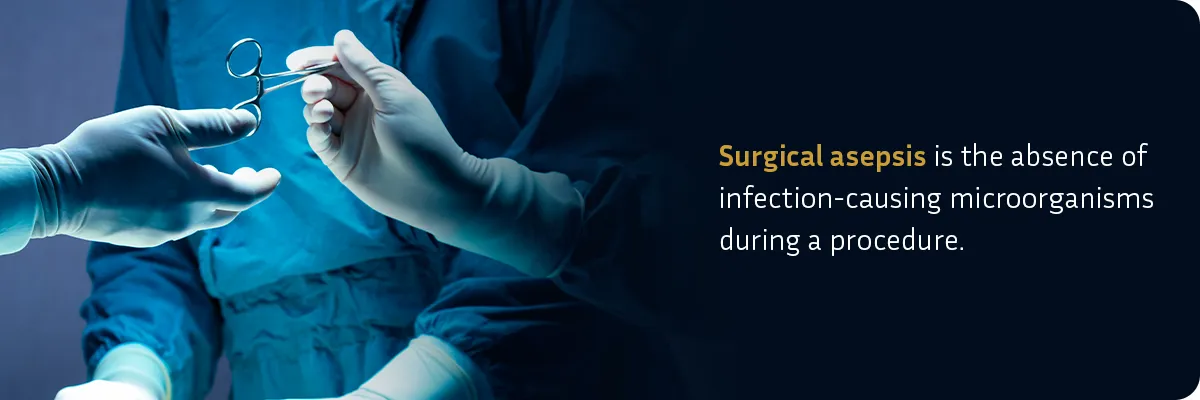
Because of their efficiency and cost-effectiveness, bedside procedures have become one of the fastest-growing segments in the healthcare industry. For example, ambulatory surgical centers (ASCs) are expected to reach a total value of $36 billion by 2023.
According to an observational study conducted in the United States, the most common invasive bedside procedures that internal medicine residents perform are paracenteses, thoracenteses and lumbar punctures. Other common types of bedside procedures include:
- Catheter insertion
- Incision drainage
- Declotting
- Pleurodesis
- Joint injections
- Biopsies
- Chest tube insertion
- Endotracheal intubation
- Blood transfusions
- Drug administration services
Depending on the type of procedure, physicians will use a variety of surgical and non-surgical instruments. Maintaining a sterile field for said instruments before and after the procedure is vital for patient health and successful medical care.
This guide to bedside instrument transport safety provides tips on pre- and post-procedure safety and sterilization and best practices for specific instruments. Additionally, we’ll cover how to keep instruments sterile during transport through the hospital and other related spaces.
Pre-Procedure Instrument Safety
With more outpatient procedures taking place as indicated by the rise in hospital outpatient revenue, the need for highly effective instrument handling techniques is becoming increasingly vital to proper bedside care. While many procedures use instruments that are pre-packaged in a sterile casing, others must be sterilized prior to procedures.
Setting up a sterile field for bedside instruments, PPE and other equipment is essential to maintaining a safe procedural environment. By prioritizing safety during sterile instrument transportation before bedside procedures, surgeons, nurses and sterile processing technicians can reduce the risk of patient infection.
Importance of Maintaining Sterile Instruments Before Procedures

The primary reason to maintain instrument sterility before bedside procedures is to ensure surgical asepsis. While asepsis is the state of the absence of infection or infectious material, surgical asepsis is the absence of infection-causing microorganisms during a procedure. The sterile technique helps maintain surgical asepsis and can be applied to any instrument. The purpose is to control and prevent infection and transmission of all microorganisms.
However, the sterile technique isn’t just used during surgical procedures — it’s also used during labor and delivery and special or diagnostic procedures. Whenever the integrity of the skin is broken, whether through surgical incision or abrasion, medical providers must handle instruments following the sterile technique. Additionally, bedside procedures like the insertion of chest tubes, IVs or catheters also follow the sterile technique.
Overall, the sterile technique principle is intended to prevent surgical site infections and other sources of patient infection acquired through bedside procedures.
Tips for Transporting Bedside Sterile Instrumentation
While transporting bedside sterile instruments, physicians must maintain a sterile field at all times. The sterile field is broken when something previously sterile becomes non-sterile when it touches a non-sterile object. Ensuring instruments remain sterile before and during bedside procedures is paramount.
Because transporting sterile instruments can open up the risk of contamination, medical staff should take precautions to maintain the sterile technique throughout the process, including during the transportation of sterile instruments:
- Review sterile technique procedures: Always check the principles of sterile technique and sterile technique protocols prior to procedures and before transporting instruments to the bedside. Note that sterile instrument transportation guidelines depend on the type of necessary instrument for the procedure in question.
- Practice hand hygiene: To maintain an aseptic state, anyone handling instruments should practice proper hand hygiene. Everyone should wash their hands and wear medical gloves in accordance with standard operating procedures.
- Wear appropriate PPE: Wearing PPE decreases the risk of transmission of microorganisms between patients and healthcare workers. PPE includes gowns, gloves and masks, all of which must also be sterile. Ensure your hair is tied back, as well.
- Provide patient education: If the patient is conscious during the procedure, be sure they’re aware of the need to prevent contamination. Ask them to refrain from sudden movements, including laughing, coughing or sneezing, and not to touch the instruments or talk or reach over the sterile field.

Post-Procedure Instrument Safety
After a procedure, instruments are no longer sterile and are considered contaminated. These instruments must also follow certain standards of transportation away from the bedside and into the sterilization area. Whether the sterilization area is on-site or off-site depends on the hospital’s protocols and the type of procedure.
Importance of Safely Transporting Contaminated Instruments Post-Procedure
In the post-procedure setting, all previously sterile instruments must be transported away from the bedside and into the cleaning area where they’ll undergo decontamination. According to the Occupational Safety and Health Administration (OSHA), decontamination is a physical or chemical process of removing, inactivating or destroying blood-borne pathogens until the point where they no longer transmit infectious particles. This process renders them safe for handling or disposal.
It’s important to transport contaminated instruments safely to prevent the spread of microorganisms and protect the instruments from destruction. However, research shows that the conventional way of transporting contaminated medical instruments using instrument trays can increase the cost of instruments by reducing their longevity and even causing an increased error rate.
By following prompt and thorough cleaning practices after bedside procedures, healthcare facilities can save on instrument costs, deliver a higher quality of care and maintain safety. Safely transporting used instruments prevents issues like cuts and abrasions from sharp tips, contact with infectious material and damage to the instruments from being improperly cleaned.

Tips for Transporting Used Instruments
When transporting used instruments back to the on-site or off-site sterile processing department, you must follow certain best practices to accommodate biohazard controls. Though procedures may vary between clinics or hospitals, the following tips generally apply to transporting used instruments:
- Keep tips of instruments pointed downward: When transporting used instruments, such as forceps, always keep the tips of the instrument pointed downward. Since fluids flow with the direction of gravity, you want to do so to prevent further contaminating the instrument or any parts of the sterile field.
- Ensure hinged instruments are open: According to ST79, the ANSI/AAMI standards for sterility assurance in healthcare facilities, all hinged medical instruments must be left open in the unlatched position in preparation for sterilization. Ratcheted instruments contain pins, racks or stringers that can be used to hold instruments in the unlatched position. This ensures proper and thorough sterilization of the entire instrument, including any crevices.
- Discard disposable instruments: After the procedure and prior to transporting used instruments to the sterilization processing site, discard disposable items, such as blades, sutures or sponges, and any medical liquids. Disposal practices should always be in accordance with applicable laws.
- Place instruments in trays or biohazard containers correctly: When placing contaminated instruments into instrument trays, place the instruments so the sharp tips are pointed downward or placed flat. Avoid allowing sharp edges to point outward or upward.
- Separate instruments by use and weight: When transporting instruments after a bedside procedure, separate the clean and dirty instruments into different trays or containers. It’s also important to divide instruments by their weight. Avoid stacking heavy instruments on top of delicate ones. Place the heaviest instruments in the container first and the lightest instruments last.
- Transport using the correct container: There are a few primary ways to transport contaminated instruments after a procedure. There are different sizes and types of containers available, and some can be fabricated using custom specifications. However, all containers must be rigid and leak- and puncture-proof, or they must be contained in an enclosed cart. Additionally, the container must be properly labeled with the biohazard symbol.
- Keep instruments moist: After instruments have been used, bioburden hardens on them, making them difficult to properly clean and decontaminate. Any hardened fluids can cause damage if left for too long. Stainless steel instruments develop pitting, so keeping them moist to prevent hardening is an important post-procedure best practice to protect instruments. Rinse instruments with a non-saline cleaning solution or water and maintain moisture while instruments are contained in the tray.
Advantages of Instrument Sterilization Cases for Bedside Procedures
Proper cleaning and transportation of medical instruments are essential to avoiding infections and preventing the spread of blood-borne pathogens. For clinics and hospitals to follow protocols based on the latest evidence or instrument processing technology, healthcare staff should consider the advantages of using instrument sterilization cases.
- Protect instruments: The priority of an instrument sterilization case is to protect instruments and keep them safe from damage and accidental drops. Instrument sterilization cases ensure tools remain functional so that hospitals and clinics can reduce the replacement costs of instruments. Ultimately, these cases provide safe transport for bedside sterile instruments.
- Proper organization: Instrument sterilization cases are an ideal way to keep instruments properly sorted. Designed to be modular, cases can store a variety of different sizes of instruments and components.
- Rigid containers: Hospitals and clinics are required to transport their instruments in a rigid, puncture-proof and leak-proof container that’s enclosed. Instrument sterilization cases are rigid containers that fully enclose instruments during transportation. This is a superior alternative to sterile blue wrap, which is capable of being punctured and provides less protection against dropping and damage.
- Custom design and configurations: Hospitals and clinics with unique instrument transportation requirements or that are seeking specific designs can have their instrument sterilization cases custom built to suit their needs. Choose from a variety of configurations, colors, finishes or coatings.
- Durable materials: Custom sterilization cases are made from durable, long-lasting materials that protect instruments and defend against the harsh conditions of sterilization. This results in longer-lasting cases by preventing corrosion and wear.
Types of Bedside Instruments
Given the wide variety of procedures that can take place bedside, a range of instruments is required. Knowing the specific handling, transportation and decontamination needs of each instrument is important when developing clinical standard operating procedures for sterile instrument transportation.
Below are some of the types of instruments that require the sterile technique and decontamination before and after bedside procedures:
- Tubes: Used for chest or esophageal intubation, with some types of tubes often being disposable
- Catheters: Used to evacuate clots, irrigate the bladder or establish a central venous line
- Knife handle: Used to hold different types of blades for a variety of procedures, including making incisions into the skin
- Scalpel: Used for making precision incisions that minimize trauma to surrounding tissue
- Forceps: Used for grasping and holding tissue in various procedures, including biopsies to obtain the specimen or tissue needing to be diagnosed
- Retractors: Used to hold back tissue to gain access to the exposed area
- Clamps: Used to temporarily hold tissue together, generally to stop blood flow or the flow of other fluids or hold a bodily structure in place
- Scissors: Used for a variety of surgical and non-surgical purposes, including making an incision into the skin or cutting medical supplies, such as bandages, sponges or sutures
- Sharps: Used for making incisions into the skin and must be disposed of post-procedure

Choose Jewel Precision for Custom Surgical Tool Solutions
When working in a clinic or hospital, it’s essential to follow proper protocols for bedside instrument transport safety. From maintaining a sterile field to following proper handling practices, there are many factors to consider when approaching how to keep bedside instruments sterile.
Instrument sterilization cases are a cost-effective, safe and user-friendly way to transport medical instruments. Sterilization cases keep instruments protected and maintain their integrity, guarding against damage and wear. Premier medical sterilization cases from Jewel Precision provide an exceptional solution to instrument transportation and protection by offering custom designs that meet every facility’s needs.
Contact us today to learn more about our rigid containers and custom designs, including our modular systems. Fill out an online form to receive a personalized quote or call 973-857-5545.